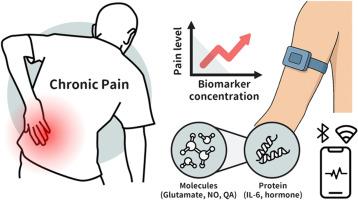An analytical review of biosensor-based chronic pain quantification in healthcare
引用次数: 0
Abstract
Current clinical methods for chronic pain assessment lack objective, quantitative measures, creating a critical gap in diagnostic accuracy. This review investigates the relationship between chronic pain and key biomarkers detectable in body fluids, such as glutamate, interleukin-6, nitric oxide, and quinolinic acid. We first discuss the biological mechanisms underlying chronic pain and evaluate the relevance of these biomarkers. The review then focuses on recent advancements in non-enzymatic electrochemical biosensors used to monitor these biomarkers. For each sensor, we summarize performance metrics including sensitivity, detection limits, and linear range, while highlighting the analytical methodologies used to establish correlations between biomarker levels and pain intensity. Our findings demonstrate that quantitative analysis of biomarker fluctuations can enhance chronic pain monitoring. The integration of sensor-based biomarker analytics with clinical workflows may offer a path toward personalized treatment plans and improved decision-making in healthcare supply chains. This review emphasizes the need for continued development of high-precision biosensors as analytical tools for translating physiological signals into clinically actionable pain metrics.

医疗保健中基于生物传感器的慢性疼痛量化分析综述
目前的临床方法慢性疼痛评估缺乏客观,定量的措施,造成诊断准确性的关键差距。本文综述了慢性疼痛与体液中可检测的关键生物标志物,如谷氨酸、白细胞介素-6、一氧化氮和喹啉酸之间的关系。我们首先讨论了慢性疼痛的生物学机制,并评估了这些生物标志物的相关性。然后综述了用于监测这些生物标志物的非酶电化学生物传感器的最新进展。对于每个传感器,我们总结了性能指标,包括灵敏度、检测限和线性范围,同时强调了用于建立生物标志物水平和疼痛强度之间相关性的分析方法。我们的研究结果表明,生物标志物波动的定量分析可以加强慢性疼痛监测。基于传感器的生物标志物分析与临床工作流程的集成可能为个性化治疗计划和改善医疗保健供应链的决策提供途径。这篇综述强调需要继续发展高精度的生物传感器作为分析工具,将生理信号转化为临床可操作的疼痛指标。
本文章由计算机程序翻译,如有差异,请以英文原文为准。
求助全文
约1分钟内获得全文
求助全文
来源期刊

Healthcare analytics (New York, N.Y.)
Applied Mathematics, Modelling and Simulation, Nursing and Health Professions (General)
CiteScore
4.40
自引率
0.00%
发文量
0
审稿时长
79 days
 求助内容:
求助内容: 应助结果提醒方式:
应助结果提醒方式:


